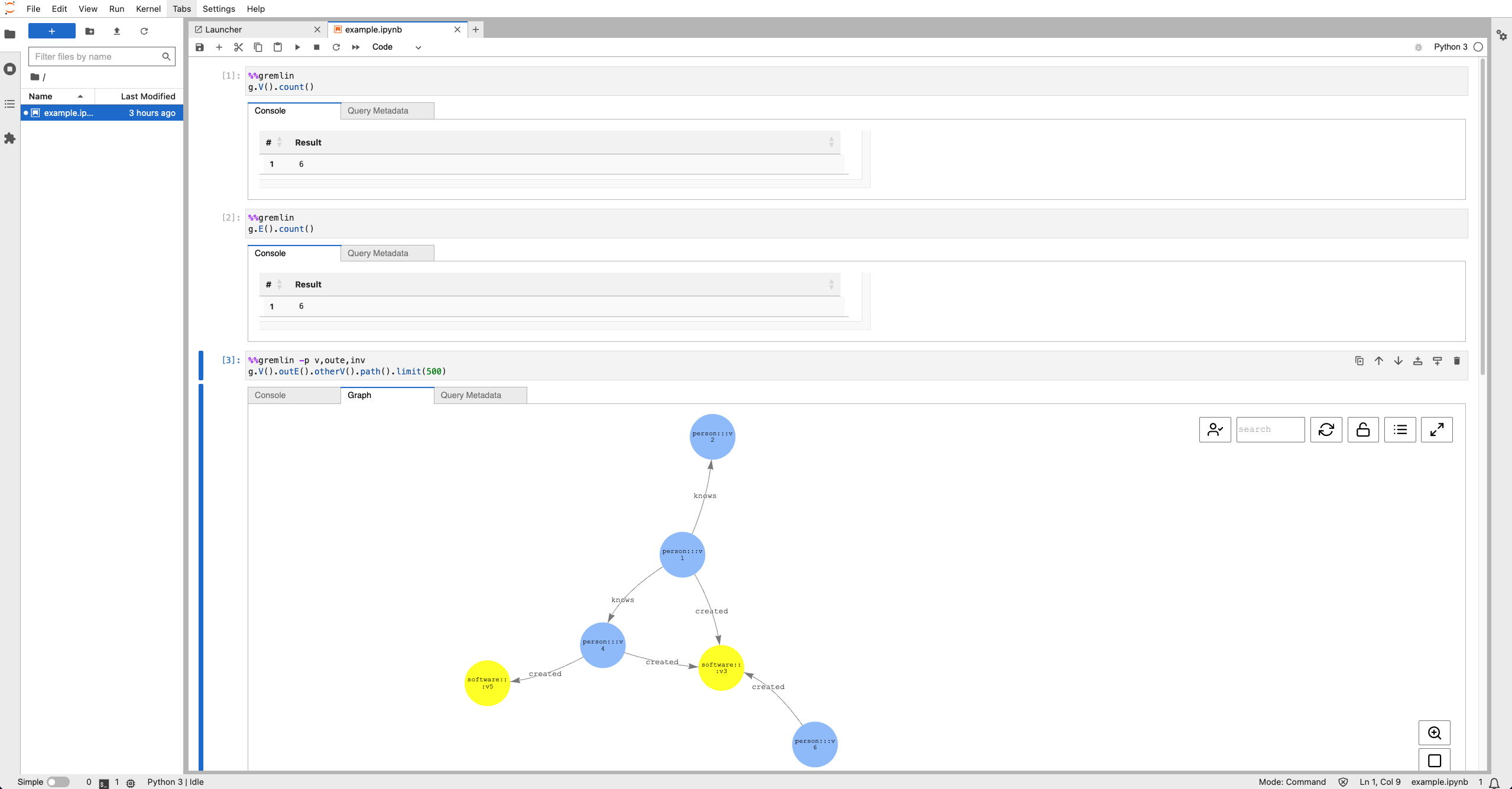Querying using Gremlin
PuppyGraph supports Gremlin, the graph query language developed by Apache TinkerPop.
Interactive Query UI
The Gremlin query tool in Graph Query offers a notebook-like user experience, complemented by the ability to visualize query results.
To access it, click the Graph Query tab on the Query page, then select the Gremlin query type.

Gremlin Console
PuppyGraph provides an interactive CLI for Gremlin queries.
To access it, click the Gremlin Console tab on the Query page.

Graph Notebook
Graph Notebook is an open-source tool that enables users to interact with and visualize graph databases directly within a Jupyter Notebook environment.
To use Graph Notebook with PuppyGraph, you need to set up a separate JupyterLab environment. Follow these steps:
Prerequisites
- Docker installed and running
uvpackage manager (install from astral.sh)
Setup Graph Notebook Environment
- Create a Python environment and install required packages:
uv python install 3.11
uv venv --python 3.11 --seed
uv pip install "jupyterlab>=4.3.5,<5" graph-notebook
- Launch JupyterLab:
-
Open the URL displayed in the terminal output (typically
http://localhost:8888/?token=...) -
Create a new Python 3 notebook and initialize Graph Notebook (first run only):
Connecting to PuppyGraph
Configure the connection to use Gremlin queries:
%%graph_notebook_config
{
"host": "localhost",
"port": 8182,
"ssl": false,
"gremlin": {
"traversal_source": "g",
"username": "your_username",
"password": "your_password",
"message_serializer": "graphbinaryv1"
}
}
Note: Replace your_username and your_password with the same credentials you used when starting PuppyGraph.
Example Gremlin Queries:
Count vertices:
Count edges:
Explore graph structure:

Client Drivers
PuppyGraph supports connecting and executing queries through Tinkerpop Gremlin client drivers.
See also Gremlin Drivers and Variants for more details on the drivers.
Python
Install the Gremlin Python Driver:
The following is an example of connecting to PuppyGraph and executing a query.
from gremlin_python.process.anonymous_traversal import traversal
from gremlin_python.driver.driver_remote_connection import DriverRemoteConnection
# Establish a Gremlin Server connection to PuppyGraph.
g = traversal().with_remote(
DriverRemoteConnection('ws://localhost:8182/gremlin', 'g',
username='puppygraph', password='puppygraph123'))
# Get all nodes (vertices) in the graph.
nodes = g.V().value_map().to_list()
print("All nodes (vertices) in the graph:")
print(nodes)
It is also possible to set a timeout for the query execution.
In this example, the whole query is submitted as a string, which is useful for graph algorithms.
from gremlin_python.driver import client
query = """
graph.program(
PageRankProgram.build()
.maxIteration(10)
.vertices("users")
.edges("friends")
.setParams("tolerance", 0.0d)
.create()
).submitAndGet()
.toList()
"""
cli = client.Client(f'ws://localhost:8182/gremlin', 'g',
username='puppygraph',
password='puppygraph123')
query_result = cli.submit(query)
result = query_result.all().result()
for record in result:
print(record)
cli.close()
Go
Install the Gremlin Go Driver:
The following is an example of connecting to PuppyGraph with the driver and executing a query.
package main
import (
"fmt"
"github.com/apache/tinkerpop/gremlin-go/v3/driver"
)
func main() {
// Establish a connection to the PuppyGraph database.
driverRemoteConnection, err := gremlingo.NewDriverRemoteConnection("ws://localhost:8182/gremlin")
if err != nil {
fmt.Println("Error creating connection:", err)
return
}
defer driverRemoteConnection.Close() // Ensure closure of connection after execution
// Create a graph traversal source.
g := gremlingo.Traversal_().WithRemote(driverRemoteConnection)
// Get all nodes (vertices) from the graph.
fmt.Println("All nodes (vertices) in the graph:")
results, err := g.V().ValueMap().ToList()
if err != nil {
fmt.Println("Error retrieving nodes (vertices):", err)
return
}
for _, r := range results {
fmt.Println(r.GetString())
}
}
Java
Install the Gremlin Java Driver:
The example uses Maven. You need to add the following dependencies to the pom.xml file of your project.
<dependency>
<groupId>org.apache.tinkerpop</groupId>
<artifactId>gremlin-core</artifactId>
<version>3.6.0</version>
</dependency>
<dependency>
<groupId>org.apache.tinkerpop</groupId>
<artifactId>gremlin-driver</artifactId>
<version>3.6.0</version>
</dependency>
<dependency>
<groupId>org.apache.tinkerpop</groupId>
<artifactId>gremlin-server</artifactId>
<version>3.6.0</version>
</dependency>
The following is an example of connecting to PuppyGraph and executing a query.
import org.apache.tinkerpop.gremlin.driver.Client;
import org.apache.tinkerpop.gremlin.driver.Cluster;
import org.apache.tinkerpop.gremlin.driver.remote.DriverRemoteConnection;
import org.apache.tinkerpop.gremlin.process.traversal.AnonymousTraversalSource;
import org.apache.tinkerpop.gremlin.process.traversal.dsl.graph.GraphTraversalSource;
public class Example {
public static void main(String[] args) throws Exception {
// Connect to PuppyGraph database using a Gremlin Server.
Cluster cluster = Cluster.build().addContactPoint("localhost").create();
Client client = cluster.connect();
// Create a graph traversal source for executing queries.
GraphTraversalSource g = AnonymousTraversalSource.traversal()
.withRemote(DriverRemoteConnection.using(client, "g"));
// Get all nodes (vertices) in the graph.
System.out.println("All nodes (vertices) in the graph:");
System.out.println(g.V().valueMap().toList());
System.out.println();
// Close all opened resources to free up system resources.
g.close();
client.close();
cluster.close();
}
}
Javascript
Install the Gremlin Javascript Driver:
The following is an example of connecting to PuppyGraph and executing a query.
const gremlin = require('gremlin');
const Graph = gremlin.structure.Graph;
const DriverRemoteConnection = gremlin.driver.DriverRemoteConnection;
// Establish a connection to the graph database using Gremlin Server.
const endpoint = 'ws://localhost:8182/gremlin';
const graph = new Graph();
const connection = new DriverRemoteConnection(endpoint);
const g = graph.traversal().withRemote(connection);
// Get all nodes (vertices) from the graph.
g.V().toList()
.then(data => {
console.log(data);
return connection.close();
})
.then(() => {
console.log('Connection closed');
})
.catch(error => {
console.error('Error:', error);
connection.close();
});
The following link is a code repository where you can learn more examples of gremlin queries.
Client Applications
Gremlin Console (Apache TinkerPop)
PuppyGraph also supports the Gremlin Console provided by Apache TinkerPop.
You need to modify the remote.yaml file in the conf directory to use the IP and port (by default 8182) of the PuppyGraph server.
In the Gremlin Console, run the following commands to connect to PuppyGraph:
